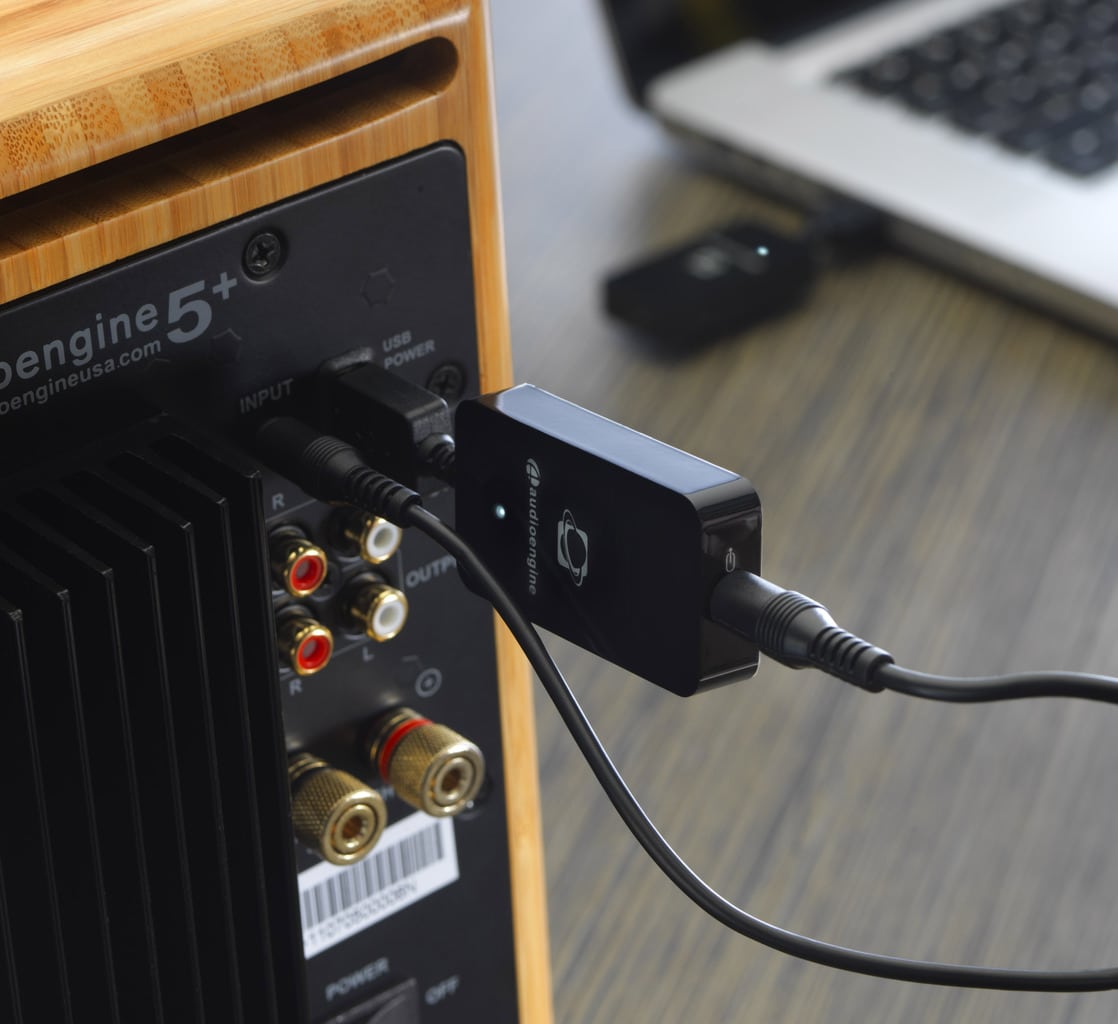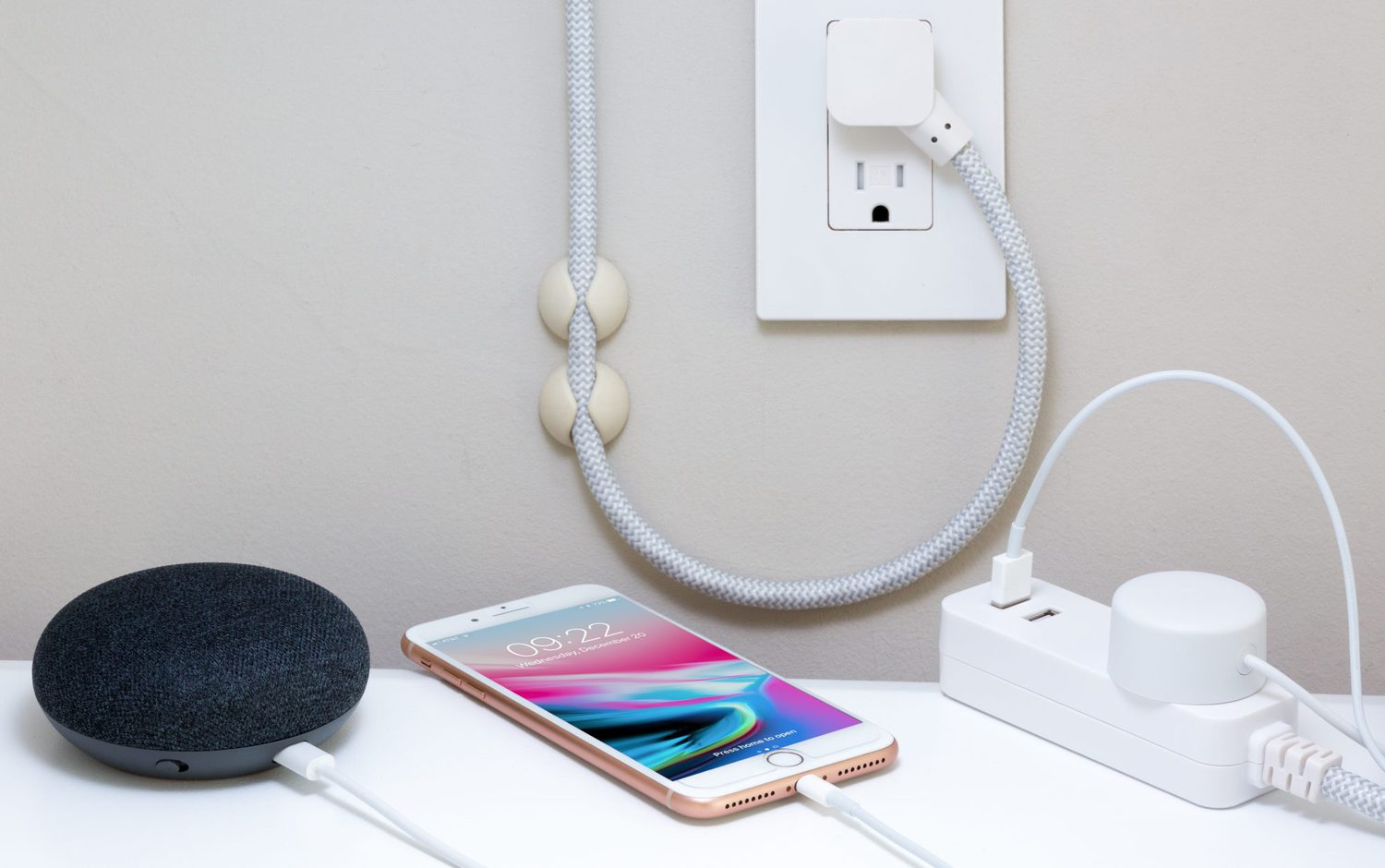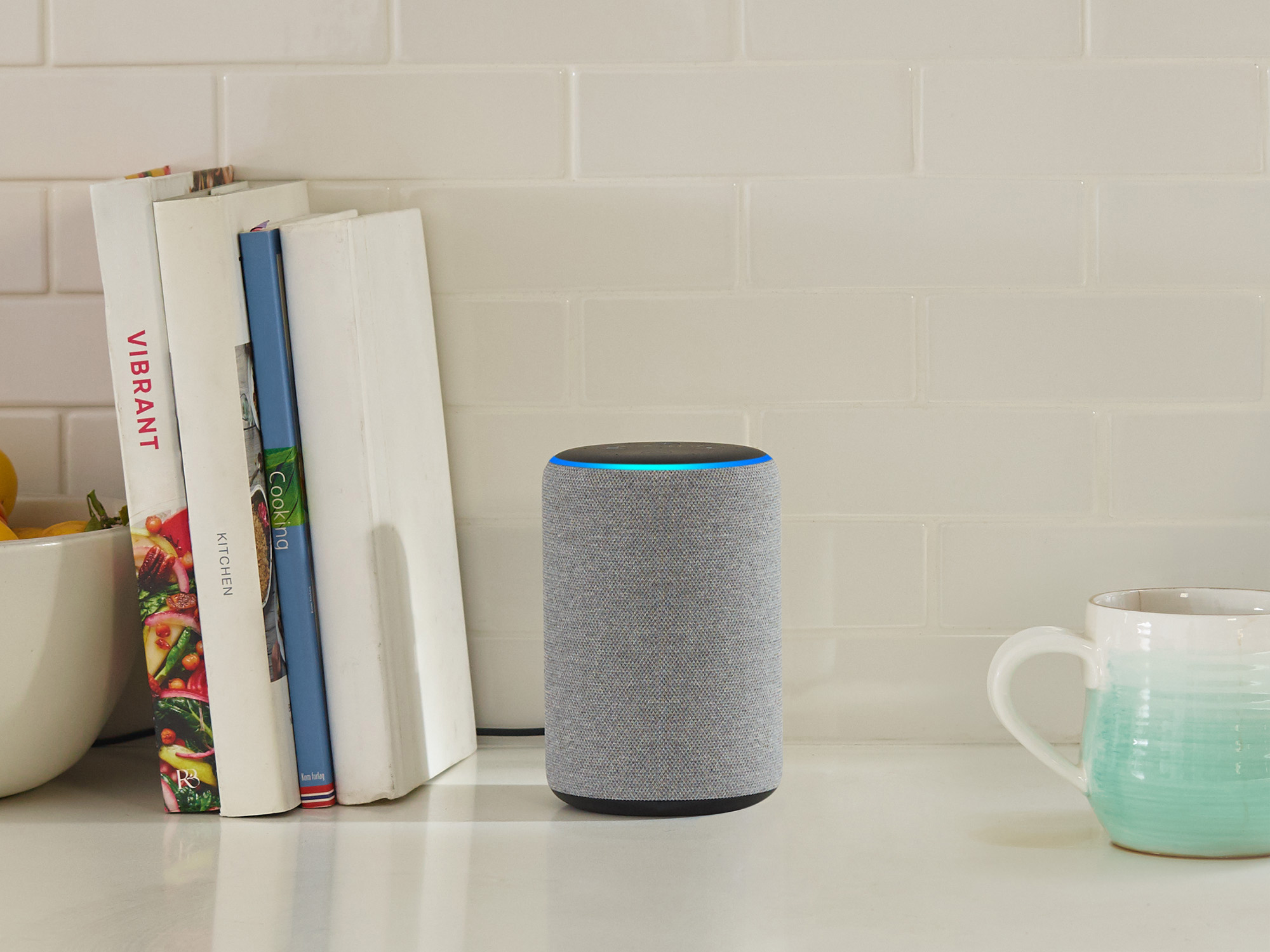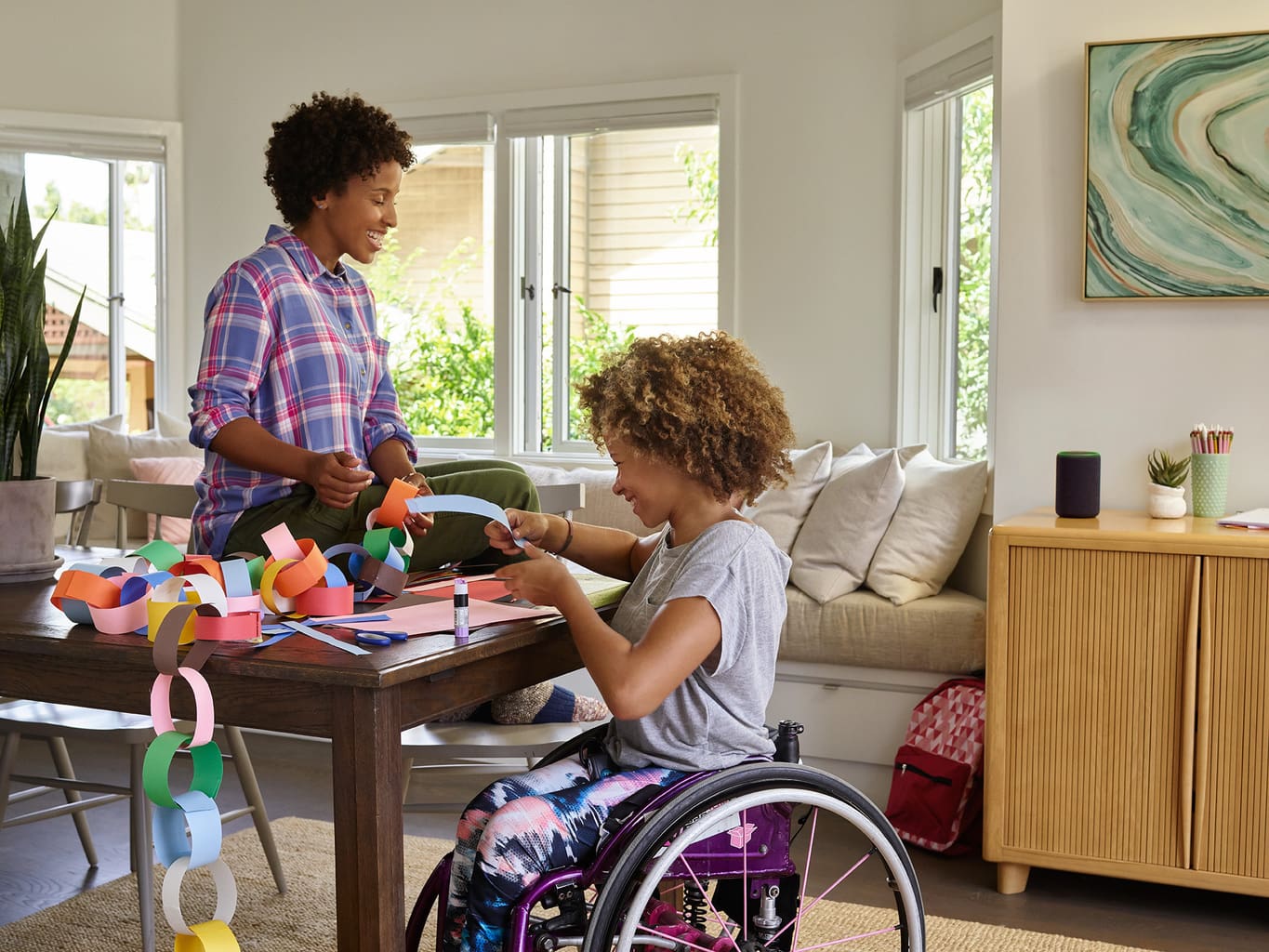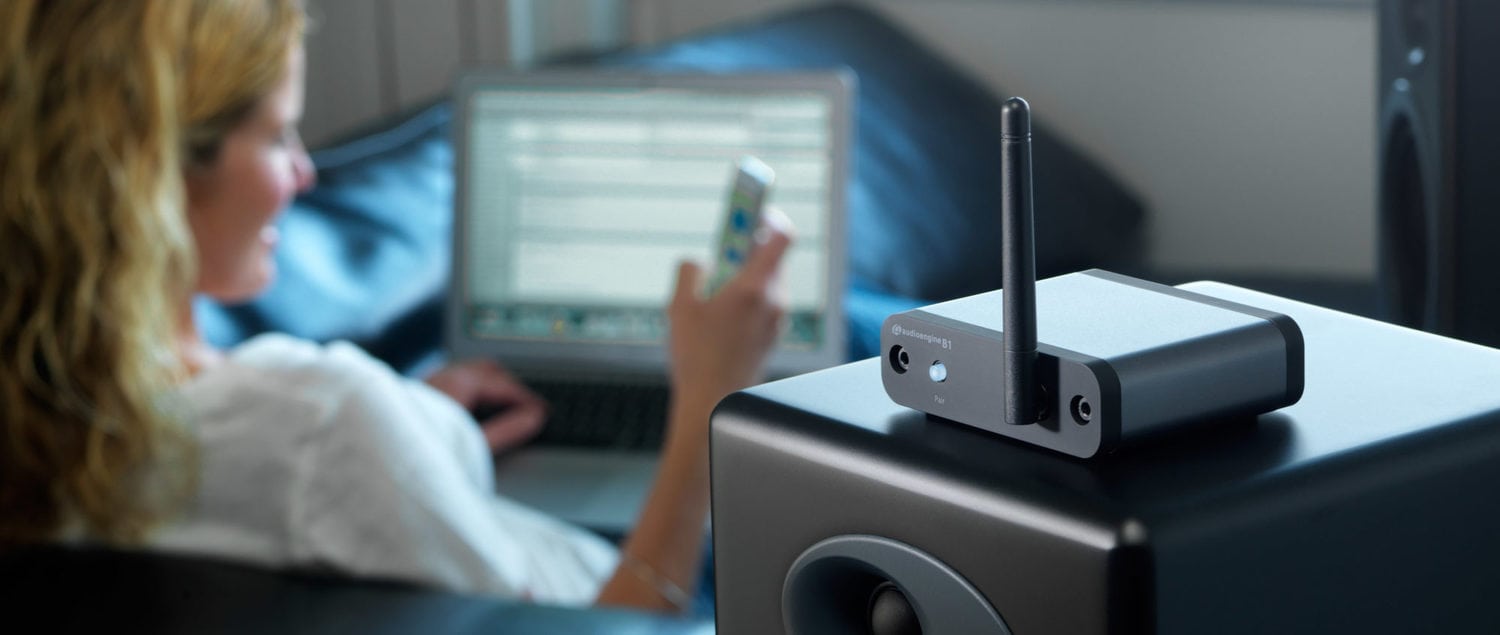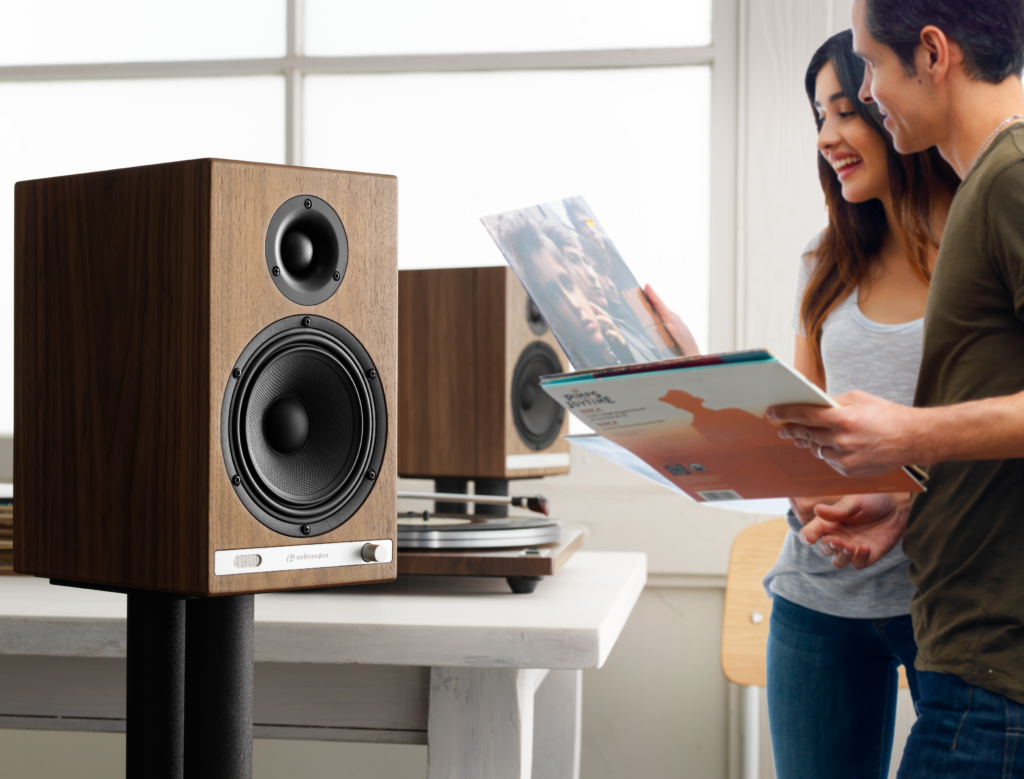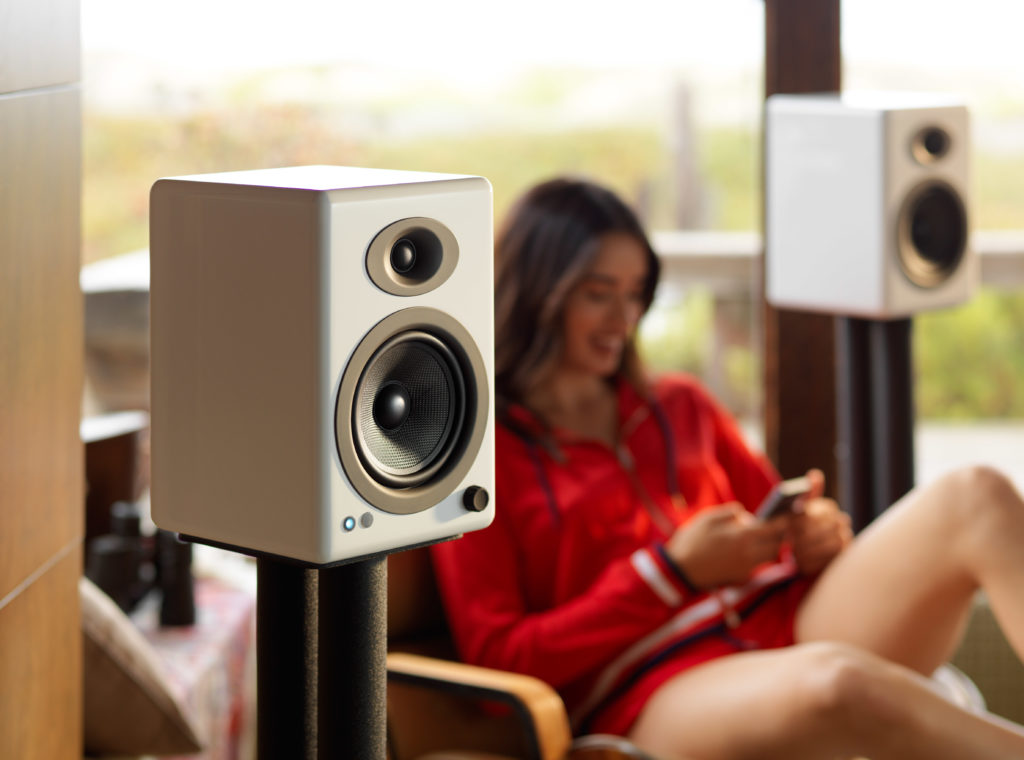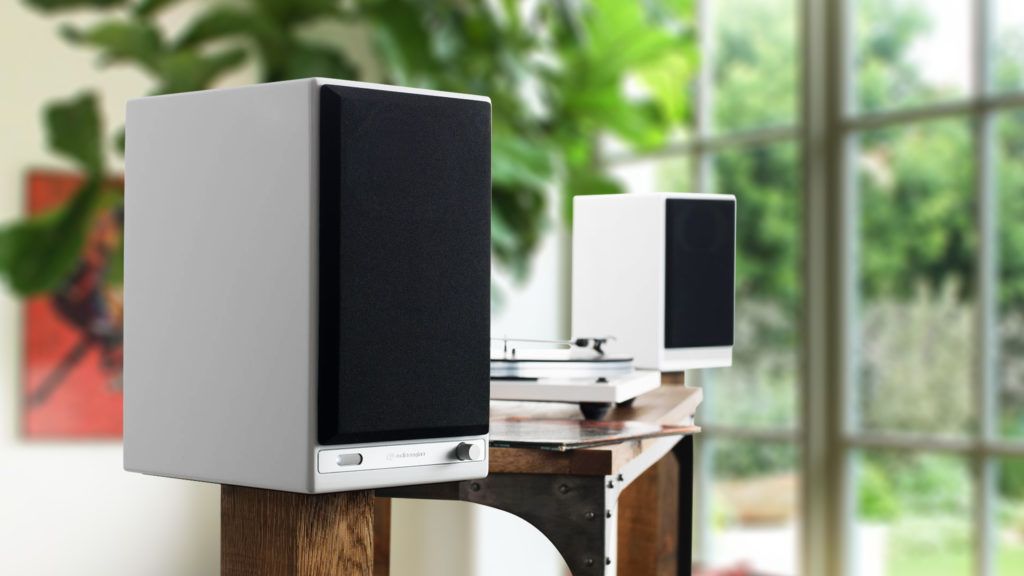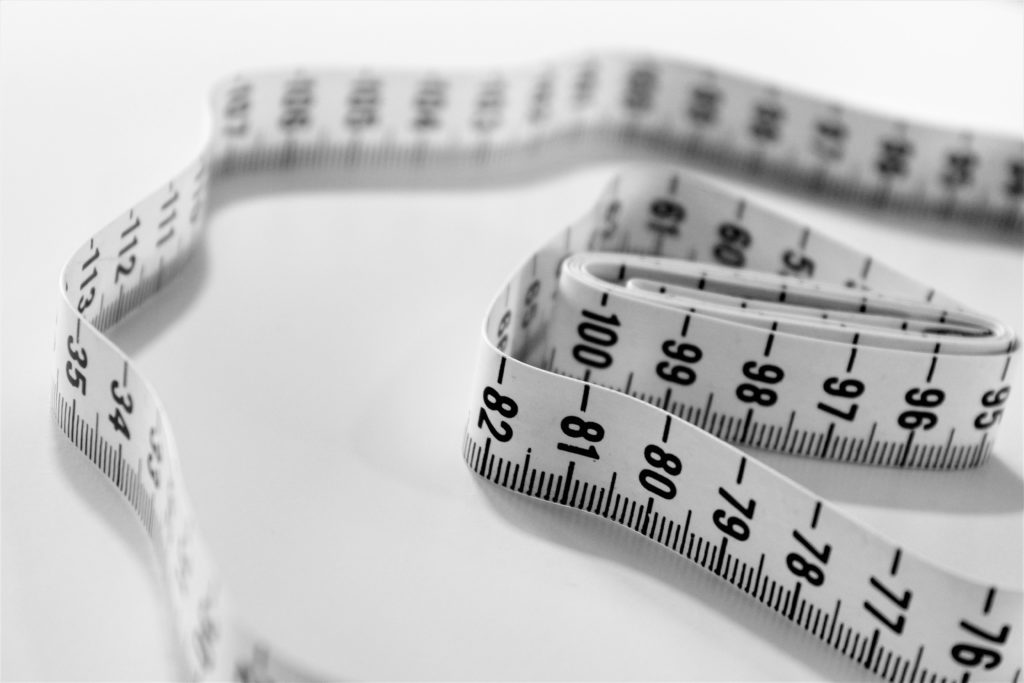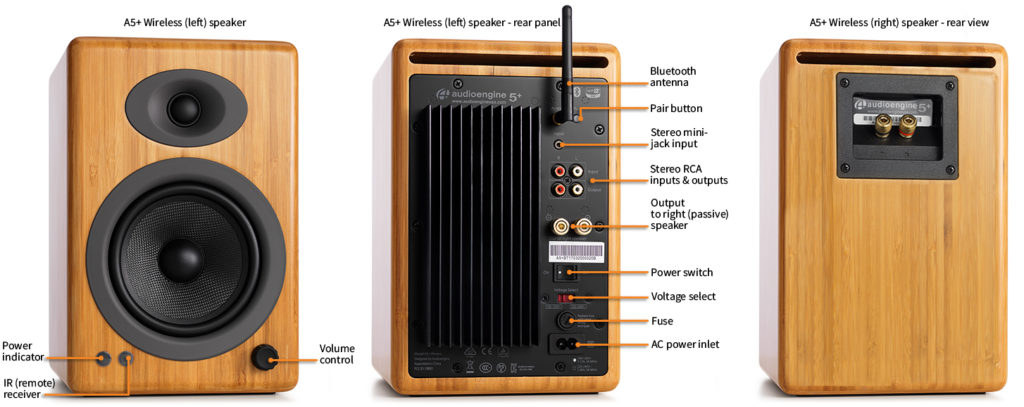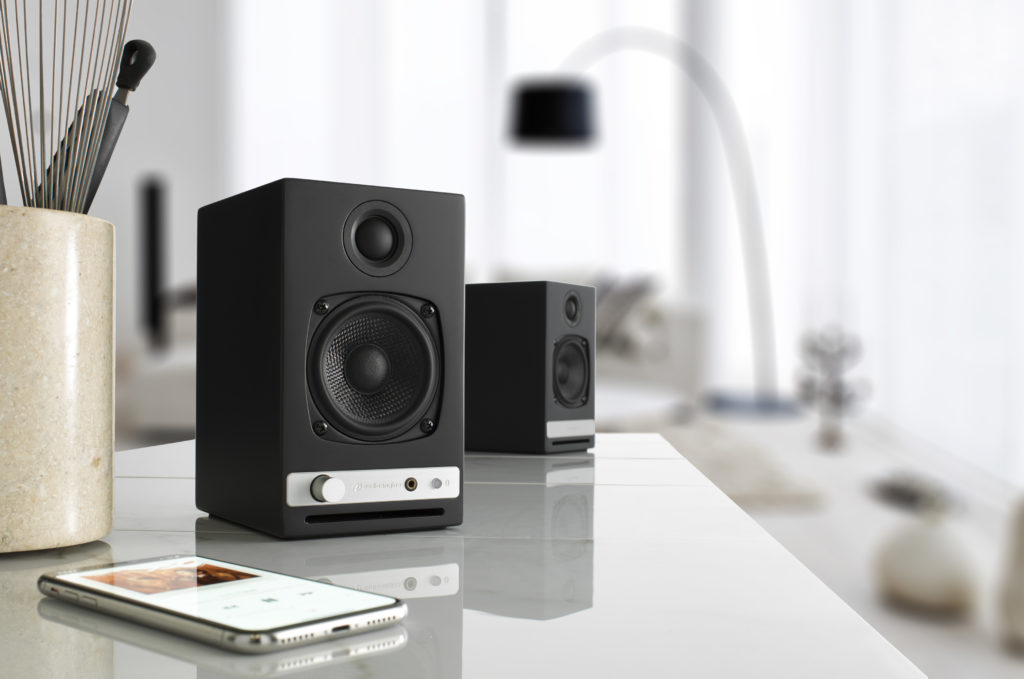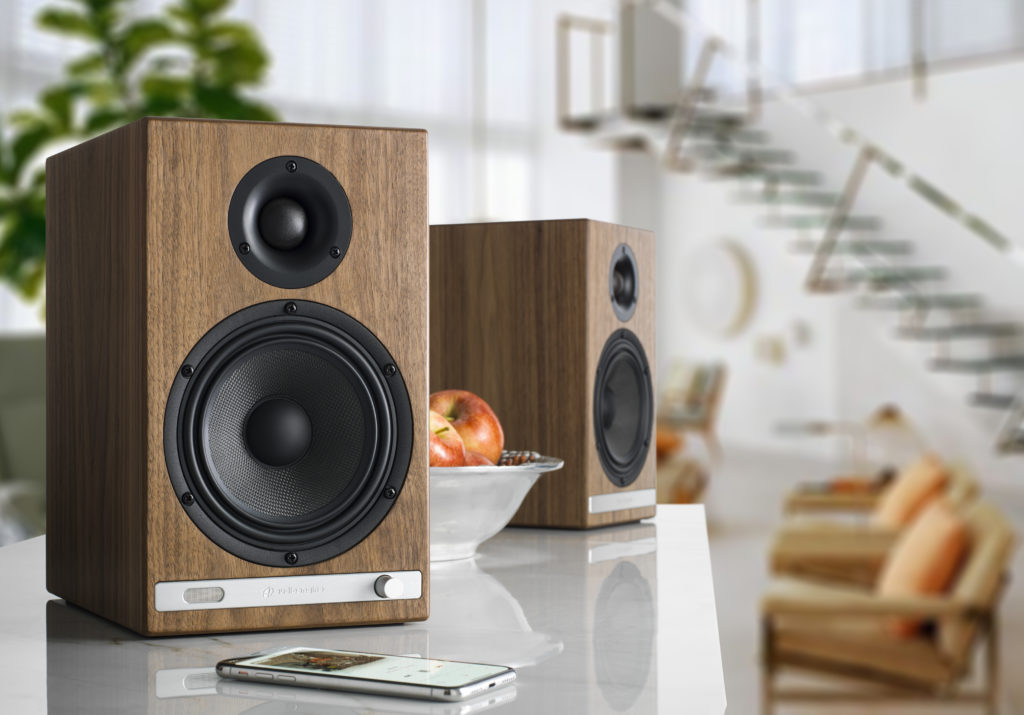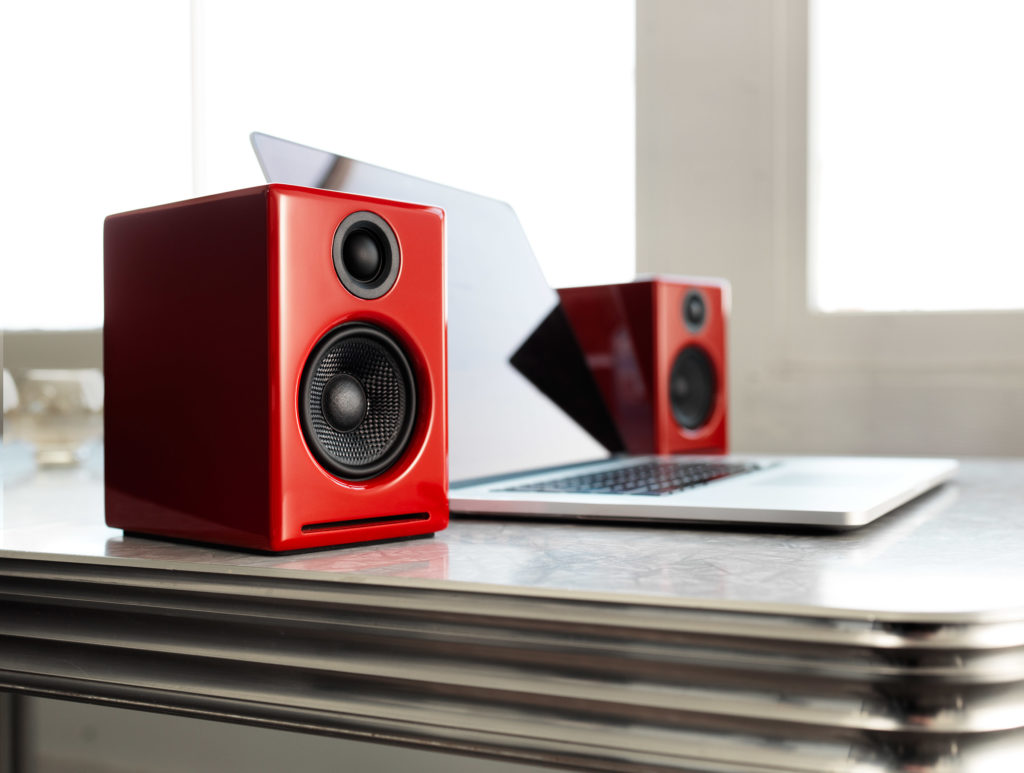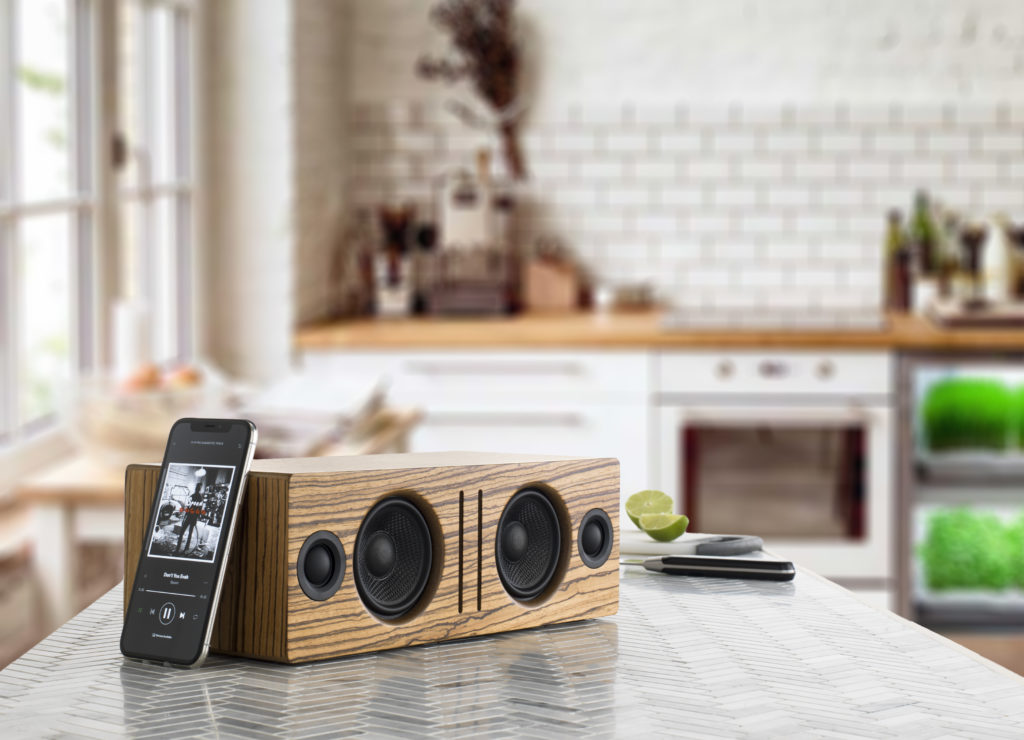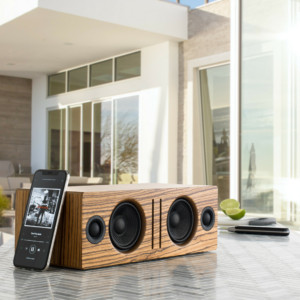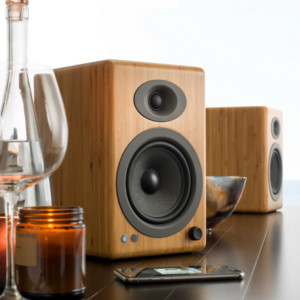How Does Wireless Surround Sound Work?
Few things match the visual and auditory experience of going to a great movie theater.
You’ve got the sprawling wide-format display, the wicked-awesome previews (and the precursory trivia, if you’re lucky), popcorn, cherry cola, and especially the immersive surround sound setup. Helicopter flybys are so convincing you might turn your head to follow them off into the imaginary horizon. Hefty subwoofers work overtime to produce every explosion, angry door slam, and menacing line uttered by James Earl Jones… you get the idea.
The concept of home theater isn’t exactly new.
Why does it seem like every piece of the puzzle has been streamlined except for the audio.
We have long had the comfortable furniture, custom lighting, great speakers, and high definition displays that can be controlled wirelessly; and while all of this is simple enough to get started with, wiring up the surround sound has always been a bit of a pain. Drilling holes into the floor and running wires up under the house is never anyone’s favorite job. Until fairly recently, you practically needed a master’s degree in home improvement to arrange a surround system in your living room. Audioengine’s W3 Wireless Adapter can get you up and running quickly, without having to punch new holes in your home.
Surround Sound
In order to visualize how Audioengine’s W3 Wireless Adapter will play a role in our system, we need to understand a few things about surround sound itself. Where traditional stereo audio has two channels (a left and a right), surround sound typically has six channels consisting of a center, front left and right, back (or surround) left and right, and a subwoofer. In two-channel stereo mixes, certain sounds are assigned to either the left or right channel or pan audio slightly more to one side than the other.
Following this same concept, a surround sound mixing engineer has to assign audio appropriately to all six channels; so when the helicopter flies by your right ear, the engineer would have had to pan the audio from the center channel to the right front and then to the right back (or surround), and also mixed in the subwoofer as necessary. It’s a big important job, and in order for us to revel in the spoils of the mixing engineer’s expertise, we must create a surround sound system with the appropriate connections to allow for true surround sound.
Most surround sound receivers will refer to these 6 different channels as “zones.” Receivers often have a powered output (meant for passive speakers) for each zone, as well as a preamp output (meant for powered speakers) for each zone. The front and rear surround zones should each require a left and a right speaker, and sometimes the center channel will also have the option for a left and right channel.
Now, when we talk about having a wireless setup, we are only talking about making the audio signal wireless, as a power signal cannot be sent wirelessly (at least not yet); with this in mind, we need to make sure the surround sound receiver we choose has all of the necessary preamp outputs (usually RCA-style connectors) for use with powered speakers.
Audioengine W3
The W3 is a sweet little device which allows for the transmission of very high quality audio over a proprietary WiFi network.
It generates its own WiFi connection between the W3 Sender and the W3 Receiver, and does not rely on an internet or WiFi connection previously established in your home. The coolest part is if your internet is sluggish or it goes out, the W3 functions completely independently from your home internet connection.
Think of the W3 as a means of eliminating the long wires you would otherwise have to run from your surround sound receiver, down through the floor (or up through the ceiling and walls), and to each of your speakers. Instead of running long wires straight from point A to point B, you would connect the outputs for each “zone,” to a W3 Sender unit. The W3 Sender unit would then wirelessly send the audio for that zone to the corresponding W3 Receiver unit, which should be connected to the input of the speakers in that zone
You are not required to use Audioengine speakers along with the W3 Wireless Adapter (although, we are quite fond of them ourselves). In fact, you can use any set of powered speakers that has a left and right channel and an available audio input. Not everyone chooses to put a subwoofer in their surround sound setup, but if you do, the same concept applies: subwoofer output on the surround system, to the W3 Sender; W3 Sender transmits audio to the W3 Receiver; W3 Receiver plugs into the input on the subwoofer. Boom! – literally.
It’s important to note that you would need a pair of adapters for each surround sound zone so that the proper audio information is reaching the speakers it is meant to reach.*
*We’re aware of some customers using just one set of W3 adapters. They send the audio from one “zone” out to a set of powered speakers and then daisy-chaining the audio out to additional sets of powered speakers. A setup like this will exhibit sound in all 6 channels, but all six channels will be receiving the same exact audio data at the same exact time, which means you won’t actually be experiencing true surround sound audio.
Once you are familiar with using the Audioengine W3 Wireless Adapter, we guarantee you will find a number of other uses for them around your house. They can be used with a wide variety of other audio products, they have a long transmission range without blips and drop-outs, and their audio quality is impeccable. So, are you ready to rig up your wireless in-home surround sound dream system?
Connecting Google Home to Bluetooth Speakers
Consumer electronics designers are, and have been, on a perpetual quest to give users the most streamlined experience imaginable.
At this point in time it seems like modern-day designers have exceeded the bounds of what most of us could have ever imagined in the first place. Think about it, there is an app for literally everything; just by downloading a simple program onto your phone or tablet, your life can become easier. Wearable technology, like Apple Watch, and smart speakers, like Google Home, tie all of your electronics together to make technology and user-friendliness a lifestyle rather than a rare luxury. Today we are going to talk a little more about one of the leading products, what it does, and how Audioengine can take it one step further; that product is Google Home.
What Is Google Home?
Offically, this piece of technology is touted as a “Smart Speaker and Home Assistant.”
A smart speaker is one of those sleek futuristic speakers that sits on your friend’s kitchen counter, plays whatever music someone tells it to, and sometimes has a snarky robotic comeback to your sarcastic remarks. There are a number of big brands making smart speakers (some of which we’ll discuss in other articles) and all of them have their pros and cons. One “pro” to the Google Home is the “Home Assistant” part. Google Home has an accompanying downloadable app that allows users to customize how the device interacts with and controls their home; lights, thermostats, coffee makers, and pretty much anything else can be controlled by Google Home and accessories. Once you have all of your desired devices properly connected and configured, turning them on and off is just one voice command away... how much easier can life get?
When it comes to music, smart speakers make calling up the right tune an absolute breeze. Google Home can control apps such as Spotify, YouTube, and iHeartRadio among others, so you can tell it to play just about any song in the world. Google Home will even call up playlists you’ve saved within your music streaming apps, and you can tell the device to increase and decrease volume, pause, skip, and any other command you would typically give a media player. There is just one drawback; while Google Home offers a few different sizes (featuring different speakers), the product’s focus is not audiophile-grade sound quality. For that, we need to bring Audioengine into the mix.
How Can Audioengine Take Google Home Further?
You’re taking a step up in the world of consumer electronics and you’ve decided to purchase Google Home; you care about user-experience and you strive to stay ahead of the pop culture curve. That doesn’t mean you have to sacrifice a quality listening experience. As I always say, what good is having access to every song in the world if you’re just going to play them through an inadequate sound system? That’s like sharpening a hunting knife so you can cut hot butter with it.
Luckily, the Google Home App (iTunes | Google Play) allows users to send audio to external Bluetooth speakers. Whether it’s the humble B2 Wireless Speaker, or a full-fledged pair of active Audioengine speakers such as the A5+ Wireless, Google Home is capable of transmitting your beloved music to your sonic system. Bam!!--we just completed the full circle of user-friendliness and ear-friendliness. It may sound complicated merely by description, but it’s actually extremely easy to configure, just follow the quick steps below:
- Download and open the Google Home App on your phone or tablet.
- Navigate to the “Devices” tab within the app
- Tap “Settings” in the devices submenu
- Scroll down to “Default Music Speaker” and tap “Pair Bluetooth Speaker”
- Select your Audioengine speaker – and you’re done!
Take control of your music.
Now you’re ready to shout voice commands all over the house and rock out while you make dinner, host a party, or do whatever it is you do. You can even connect multiple sets of Audioengine wireless speakers for multi-room audio, by creating “groups” in the Google Home app (under that same “Devices” tab).
Isn’t it nice that designers have created all this awesome technology for us? Now I’m just spit-balling, here, but -- what if one day someone will make some kind of like a smart speaker... except it lives in your brain and reads your mind. Then you can just think about how good your favorite tunes will sound through a pair of Audioengine wireless speakers, and voila!
Can Alexa Connect to Bluetooth Speakers?
Remember how in old science fiction movies a character could just talk out loud to a spaceship and it would do anything they commanded?
The idea of voice control technology has long been embedded in our expectations for the “future”, and even though most of those old science fiction movie-makers couldn’t imagine computers any further-advanced than those already available in 1979, they certainly hit the nail on the head with their forecast of voice control. Nowadays, with the help of products like Amazon Echo (and its voice-controlled personal assistant ‘Alexa’), users can control aspects of their home just by verbalizing simple commands. But even with the huge strides this technology has made in recent years, it’s impossible to get audiophile-quality sound from the speakers in an Amazon Echo product. Audioengine can help with this, but before we dive into how, let’s talk a little more about the Amazon Echo.
Is your Amazon Echo killing your audio quality?
First, while Echo and Alexa do in fact go hand-in-hand, they are not the exact same thing.
Echo is a line of smart speakers manufactured by Amazon, and Alexa is an intelligent personal assistant software used to control Echo. Users can speak aloud to give Alexa, and therefore Echo, verbal commands (always beginning with the wake word, ‘Alexa’) such as, “Alexa, play my favorite song,” or “Alexa, what’s on my calendar this Saturday?” Alexa will respond accordingly, so long as the questions asked or commands given are within Alexa’s realm of capability. With tons of Echo-compatible add-on products on the market, there really isn’t a whole lot that falls outside of Alexa’s wheelhouse.
The most common commands Alexa handles are music-related: whether it’s calling up a Spotify playlist, turning up or down the volume, or finding a specific song you haven’t heard in years but are randomly thinking about and absolutely have to hear right this second!! The accessibility is astounding, no doubt, but its main consequence is that you are forced to listen to all your music on Echo’s built-in speakers instead of your own beastly audio system. This is not to say Amazon has ignored their sound quality altogether, but realistically there’s only so much a single speaker housing of that size can handle. Suffice it to say, there are limitations.
Luckily, Amazon has implemented a crucial feature which expands its functionality to accommodate customers who want to be able to interact with Alexa and still enjoy listening to podcasts, music, and stock tips through exterior systems. That’s right, it’s quick and easy to connect your Echo to Bluetooth speakers:
- Open the Alexa App (Apple link | Google Play Link)
- Tap the “Devices” icon and select the Echo device you want to connect to speakers
- Select “Bluetooth Devices”
- Select “Pair New Device”
- Find your Audioengine Wireless speaker on the list of available Bluetooth devices
Bang, you’re done!
Now you can treat Alexa as if it were any other input device; you can still have whatever other devices you so choose connected to your Audioengine speakers, and since Alexa can control Echo’s volume with a simple, “Alexa turn down volume,” you can leave Audioengine’s volume knob exactly where you like it and adjust volume accordingly with Alexa. If you have our S8 Powered Subwoofer connected wirelessly to your mains, this configuration will still work which means you’ll get full-spectrum high fidelity audio when listening to all your favorite songs, without sacrificing the unparalleled convenience provided by a product like Amazon Echo. This will also work with our standalone B1 Bluetooth Music Receiver in the event you have a set of wired speakers you want to turn into wireless speakers.
Modern technology is really opening up doors... and windows... and exhaust fans... it’s basically blasting the roof off the whole place.
We are reaching the point where we can do just about anything we want with voice control technology, as long as we have all the right accouterments. Products like Amazon Echo make life so easy it hurts... perhaps it hurts so good that you want to lie down and say, “Alexa, play ‘Hurts So Good’ by John Mellencamp.” Don’t worry – we designed Audioengine Wireless speakers to do the rest.
What Is Bluetooth aptX HD?
In short technical terms, aptX HD is an audio codec that supports 24-bit audio file transmission via Bluetooth and reduces signal-to-noise ratio, resulting in lower distortion.
Now in plain terms, aptX HD allows you to send audio of dramatically higher-quality from your phone, tablet, or computer than other wireless formats. AptX HD really is a breakthrough in easy-to-use technology and a must-have for all your music.
Why Do You Need It?
Need is such a funny word and that’s why this topic gets a bit subjective.
The fact is, you may not need aptX HD if you don’t care much about having access to pristine HD audio at all times. Some listeners will find traditional Bluetooth audio to be perfectly satisfactory; this is sort of an “out of sight, out of mind” situation. The truth is, many listeners aren’t even aware that they are losing audio data during wireless transmission; they don’t realize that the best details of their music, movies, and games are all getting misplaced over the air.
In our experience, however, when a listener is introduced to audio sent via aptX HD they are instantly able to tell the difference. As soon as users get one taste of the luxurious transmission range and lossless, buttery sound of aptX HD, it is highly unlikely they will ever go back to using a lesser Bluetooth codec. AptX HD audio is, to put it simply, superior in every way to that of older standards and the difference can be heard by audiophiles as well as novice or casual listeners alike.
For a more in-depth look at what aptX HD is and why you need it and for a breakdown of the technical differences between aptX HD and standard Bluetooth, please read our article on Bluetooth Audio and Codecs.
How To Know If Your Devices Are aptX HD Compatible…
In order for you to actually take advantage of aptX HD, both the “sending” and “receiving” devices need to support aptX HD.
If you are using Audioengine's A5+, HD3 or HD6 home music systems on the “receiving” end of the wireless setup, you are starting off on the right foot as all of these wireless speakers come stock with the aptX HD codec implemented and ready to roll. Now, let’s take a look at your “sending” device to determine its compatibility. AptX HD was developed by a company called Qualcomm. Qualcomm is doing an excellent job by working with consumer electronics manufacturers to get aptX HD integrated into as many smartphones, tablets, headphones, etc., as possible.
You can find a full list of devices which are currently aptX HD compatible on Qualcomm’s website by clicking here.
Checking this list is, by and large, the easiest way to determine whether or not your “sending” device is aptX HD compatible.
There are a number of manufacturers out there who have taken the step towards providing better audio by electing to include the aptX HD codec in their music systems; but there are also a great many who have, thus far, opted out. Apple, for example, has decided, for the time being, to stick with the AAC codec -- which is still high quality, although not commonly accepted to be on the same level as aptX HD. Luckily, Audioengine products are still compatible with the AAC codec as well as standard aptX and SBC.
So even if your smartphone or tablet does not offer aptX HD, you should still be able to transmit standard quality audio via Bluetooth to your Audioengine Wireless Home Speakers. And also try to be patient as aptX HD is growing rapidly in popularity and Qualcomm is adding new products to their list of compatible devices every day.
Building the Ultimate Audio System
Step 1: Powered Speakers
A high-quality pair of powered speakers is the keystone of any home entertainment setup.
Today let’s look at what our A5+ Wireless Speakers bring to the table. Our designers spent years perfecting the design, sourcing the exact right parts, and tuning every frequency of this inceptive monument. Close attention was paid to the small components used in the power and preamp sections of these speakers, and we also paid that same attention to the larger components in these monsters. The woofers, tweeters, and cabinets are all essential to the distinctive sound of the A5+ Wireless, and these ingredients were combined to a product with beautiful high fidelity sound reproduction and a surprisingly broad and tangible stereo image. Without a solid foundation, it doesn’t matter what pieces comprise the rest of your system; these speakers are the very bedrock of a calculated sound system.
Step 2: Upgraded Cables
Although the A5+ Wireless are, in fact, wireless speakers, this doesn’t mean all of your connected devices will be wireless capable, so you’ll need some quality interconnects.
Now, you might be wondering if the supposed quality of cables really makes a difference, or if something so seemingly insignificant could possibly have an effect on sound or user experience. To be plain, quality is quality; whether it’s paperclips or rocket ships, we can all tell the difference between something well made and something cheaply made.
Cables are no exception; without wires made from dependable, quality-controlled metals, your audio signal will actually suffer. Without robust insulation and solid connectors, the lifespan of your cables will lessen drastically. This is why we have our interconnects manufactured, by hand, right here in the USA, using first-rate materials chosen for the way they work together.
Step 3: Subwoofer
Often times subwoofers are overlooked, and even though a good set of powered speakers goes a long way on its own, a well-matched subwoofer can take a home audio setup to the next level.
The Audioengine S8 Subwoofer was designed to pair perfectly with Audioengine’s many powered speaker systems, giving you control of the frequency crossover, phase, and volume of the subwoofer, separately from the main speakers. These features, along with the subwoofer’s low-key aesthetic, allow you to experiment with the placement of the woofer as well as the shape of the sound it produces.
Adding a subwoofer to your system lets you hear and feel an entirely new dimension of sound, and brings an unprecedented dynamic to your movie-watching, gaming, or music-listening experience. And just think, you can even use those upgraded Audioengine cables to connect the S8 Subwoofer to your A5s!
Step 4: Sanus Steel Series Speaker Stands
Exacting the placement of your speakers is critical to getting the most out of your system, which is why we endorse the Sanus Steel Series Speaker Stands.
We offer the stands in two sizes, 34” high and 26” high, because every room is different, and depending on how high your ears typically sit while listening, you’ll need to prepare accordingly. Stands can free up space on your mantle, bookshelf, or entertainment center, and will allow you to get the speakers an appropriate distance away from any back walls; this lets the speakers breathe and results in enhanced low end response. Adding a set of speaker stands can even help with the aesthetic of the room, and can dampen annoying vibrations otherwise caused by placing your speakers on a less stable surface.
The home audio system is a microcosm. Every piece, large and small, has a vital role to play in how the system functions. The quality of the parts makes up the quality of the whole, and Audioengine is proud to offer a full line of top-notch parts that make up one harmonious whole.
[Find out what speakers are best for you. Take the quiz]
Which Speakers are Best for You?
For their first few years Audioengine offered two products; the A2 Desktop Speakers and the A5 powered bookshelf speakers. And after seeing the success of these we decided to venture into more great products, eventually adding wireless capabilities, passive speakers, and other options to our lineup. These days if you find yourself browsing the Audioengine webstore you might think it a bit difficult to decide which of our awesome products is right for you. But rest assured, we have something for everyone and want to make it easy for you to decide, so we’ve come up with a list of questions you should ask yourself when shopping…
Do I need passive or powered speakers?
A big important question indeed, but an easy one to answer.
Powered speakers are an all-in-one solution to your stereo system needs. They include both the amplifier AND the speakers. These are great if you want the full Audioengine experience and if you don’t already have an amplifier that you absolutely love. A situation in which you would only need passive speakers is if you had an amplifier or AVR that you couldn’t part with. Not to worry, if you do love your existing amplifier, our P4 and HDP6 passive speakers will pair perfectly with and give new life to any amp!
Do I Need Wireless Speakers?
This will depend heavily on the devices from which you wish to play your audio.
If you are looking for a set of powered speakers to play audio from a turntable or even an old tape deck you found in the attic, you really won’t need to worry about having wireless speakers. Devices that are strictly analog should have the appropriate analog outputs required to connect directly to the inputs on our A2+ and A5+ speakers. However, if you know you will want to stream music from your laptop, tablet, or phone, you’re definitely going to need to be in the wireless market; which includes our B2, HD6, HD3, and A5+ Wireless speakers. All of these are great options so your decision may lean on the next topic.
Related: Audioengine A5 vs HD5: What is the difference?
Does Size Matter?
The short answer is, sorta kinda.
If you have a specific physical space you’re working with and need a speaker that fits, of course it matters. Smaller options include the A2+ and the B2, where larger speakers include HD6 and A5+ music systems. But the more important aspect is power rather than size. And yes, power definitely matters. While even the Audioengine speakers of lesser power still pack a major punch, it is important to consider the space the speakers need to fill. If you are going to use your speakers outdoors for parties or gatherings, it’s probably best to consider a higher-power (or louder) speaker set such as HD6. But if you just need to connect your computer to some speakers to watch Youtube or listen to iTunes in your bedroom, the B2 will work great!
Audioengine speakers offer a 30-day audition and a 3-year warranty. So, if for some crazy unlikely reason you aren’t happy with your speakers or if they malfunction, you’re covered!
The simple fact is, we do make something for everyone. There are always a few factors to consider when making a purchase but hopefully this quick writeup gives you some insight on how to make the best speaker buying decision. In any event, we know you’ll be blown away by the unprecedented listening experience you’ll get out of Audioengine speakers.
About Audioengine
6 Simple Wireless Speaker Shopping Tips
So you’ve decided to make the leap from wired to wireless music and might have made the mistake of Googling “Best Wireless Speakers.”
We here at Audioengine know how overwhelming this can be and we extend our deepest sympathies. But it’s time to put your concerns to rest as we’re here to give you some important buying tips… and yes, you may need these tips to make it through this with your sanity intact.
Before we start, let it be known we are not trying to sway you in any particular direction but we only want to make sure you’re aware of a few items that could go overlooked. And the majority of the following advice can be applied to pretty much any purchase you’re making in the audio world.
[Find out what speakers are best for you. Take the quiz]
Price point
As with anything, it is important to start by setting a budget for yourself and finding a product that aligns with this budget.
There are a ton of great wireless products out there, some of them are practically being given away, and others might cost your life savings. No matter your budget, one fact remains: a quality wireless speaker setup doesn’t HAVE to be expensive. Conversely, you often get what you pay for, so it is wise to be wary of a product whose price tag looks more like a shoe size if you catch my drift.
Features
Another important point that will assuredly be different for everyone is the inclusion of features.
If you’re looking for a simple wireless speaker with no options and no extra inputs, then don’t bother spending hours comparing products that are saturated with bells and whistles. If, on the other hand, you know you want the option to connect an analog device like a stereo or surround sound receiver, for instance, make this determination early and stick with it. There will always be an option to suit your exact needs so don’t feel pressured.
Reviews
Reviews are king in today’s world.
Everything from the usability of a product to the competence of a company’s customer service team can be scrutinized in an online review, and that’s why it’s obviously important to read as many reviews as you can find (and to also read between the lines with some of these). A responsible company addresses negative reactions and does not let any concern go unnoticed. Reviews not only tell us how customers react to a product but how a company reacts to its customers. And the way a company reacts to its customers can tell you whether you’re making a good or bad purchase.
Warranties and trials
This is always a fun one! If you’re having trouble deciding between two or more products because they have the same features and similar reviews, why not go with the one that offers a trial or a better warranty?
The wireless audio market is extremely competitive, and most companies are offering a brief trial period with no penalties or full-coverage or even an extended warranty period. The fact is, a company with a truly great product has nothing to fear and is confident in their product’s ability to satisfy anyone and everyone.
Portability and durability
Where are you going to be using these speakers? Are you going to sling wireless audio from the kitchen to the living room, or are you taking this setup down to the park for a picnic? Do you need the speakers to be battery powered? Waterproof?
I know, I know, asking way too many questions but you should be asking these questions too! Again, there will always be a product that suits your needs for portability — and often times, if the speakers are easily portable, they will also be durable to some extent. The caveat is that certain other aspects of the speakers will inevitably suffer. Sound quality, aux inputs, wireless range, etc.; these are all things that have the potential to “get the boot” the more portable or waterproof your speakers need to be.
Sound quality and wireless range
Obviously we want our wireless speakers to sound great and to not drop out or lose signal EVER.
The sound quality of the actual speaker itself is something you may need to derive from customer reviews, unless you have the option to actually hear the speaker before making a purchase. Apart from that, it’s best to read up on the company, what materials they are using, and what the speakers can be compared to, etc.
But when it comes to the sound quality of the actual WIRELESS itself, you’ll need to look out for a few things. Wi-fi or Bluetooth and other fun terms all define different ways a speaker can receive wireless audio information and process it. Each of these has its own pros and cons, and some will be more or less suitable to your particular setup. Wi-fi is good if you want to transmit audio to multiple speakers at once but Bluetooth has a much easier setup and the ease-of-use is a HUGE advantage. But for the best sound quality AND ease-of-use, you will want to look for Bluetooth products that use the aptX or aptX HD “codecs”. These will give you the best audio quality possible, and with Audioengine, the longest range as well. If you wish to get into more technical details about this type of wireless audio, please read our article on Bluetooth aptX HD technology.
In summary, there are a myriad of products on the market and all have their pros and cons. To get started, make a list of things you want and need out of your music system. Determine what is necessary, nice-to-have, and what you don’t need. Then when you make the detrimental error of Googling, “Best Wireless Speakers,” you might make it through to the other side with your sanity intact.
Still struggling with choosing the right speaker? Take our quiz and make it easy!
Speaker Setup – How to break in new speakers.
So you just got your brand new Audioengine speakers and you’re ready to pull them out of the box and get them set up so you can start rocking out.
Straight out of the box, your speakers should sound great, but what if your speaker setup could sound better with time?
One thing that you can easily do to make that new speaker setup sound top-notch is a thing called “break-in” and it’s actually really simple.
So why would you want to break the speakers in?
The materials we use for our speakers are quite robust, so right after manufacturing they can be a bit stiff.
One way to help out with this stiffness is to break them in so that these materials, such as the rubber surrounds of the aramid fiber drivers, loosen up. As mentioned earlier, the speakers should sound great from your first listen, but after they move around a bit and loosen up you should notice smoother low end response and sweeter mids/highs.
From time to time, we get asked about how to break in new speakers.
The break-in period doesn’t really require anything special other than listening to music and over time your speakers will become more and more broken in.
For proper break in, we generally recommend around 40 to 50 hours of at least mid-level playback before doing any critical listening. Some our customers have mentioned that they play tones or white noise while they are away, such as while they’re at work, to help the process along, but we’d recommend just listening to them normally at a medium-level during the break in period.
Breaking in your new speaker setup is a simple and crucial thing to do to make your speakers sound better and open up their potential. Some things do get better with age!
Audioengine – Doesn’t Your Music Deserve It?
How to Stream Music from my Phone to my Stereo?
We want things to work, is that so much to ask?
There is such a mass of technology and gadgetry available out there today that, for the most part, the good stuff sticks around and the bad stuff is pushed right out the door, never to be seen again. But when it comes to streaming music from our phones to our stereo systems, we sometimes still have to jump through hoops to get our gadgets to see eye to eye.
Rest easy, friends, for today I am here to make it very very easy. Let’s talk about a couple of ways Audioengine can get your music streaming from phone to stereo in less than 1 minute!
Using Audioengine Wireless Speakers
If you are one of the TRILLIONS of highly intelligent individuals who have already purchased a set of Audioengine wireless speakers (this includes the HD6, HD3, A5+ Wireless, and B2 speakers), you are in luck, as this is the easiest possible way to get your music streaming.
To get the system up and running in general, all you have to do is take your speakers out of the box, plug the left speaker into power, connect the left speaker to the right speaker via the included speaker wire (does not apply to B2, it's just one little speaker), and flip the power switch to the ‘On’ position. After the speakers are on, the only thing left to do is find the speakers on your phone’s list of available Bluetooth devices, and select them. They will pair within seconds after just ONE click! You’re done -- can you believe that!? Sheesh, that was easy. But what if you don’t have a pair of Audioengine wireless speakers?
Using Anything Else
Okay so maybe you don’t have a pair of super awesome wireless speakers, that’s cool, Audioengine can fix that in less than a minute using our B1 Bluetooth Receiver.
The same principals will apply from the previous section, but first, we have to MAKE our non-wireless speakers into wireless speakers. Let’s unpack our B1 Bluetooth receiver, connect it to power, and then run cables from the analog OUTPUTS on our B1, to the analog INPUTS on our existing speakers. Boom -- now our speakers are wireless, crazy right? The final step is the same as before; just locate B1 in your phone’s list of available Bluetooth devices and click. You’ll be paired in seconds and ready to rock that Duran Duran Greatest Hits album you just downloaded.
Keep in mind, once you’re paired like this, you should be able to stream any and all audio from your phone to your speakers. This means, iTunes, Spotify, Tidal, Pandora, everything. Everything!
No more banging your head against the wall trying to get things paired up, no more proprietary passwords, and no more having to reconnect every ten minutes. It really is the best way to stream music from your phone to your speakers, no matter what kind of speakers you are using.
Now, why don’t you stream your way on back to our Wireless Speakers and see what you’re missing out on!
How to Connect a Turntable to Audioengine Speakers
Even though records can be seen by some as an archaic music format, the truth is vinyl is still alive and well with many young people collecting vinyl records that were either handed down from their parents or found in a bin of used records at their local record or thrift store.
Obviously, every budding record collector needs a turntable and luckily they are extremely easy to set up. Here’s how to connect a turntable to Audioengine speakers.

Turntables with Built-In Preamp
Turntables Without a Built-In Preamp

Bluetooth-Ready Turntables
Where to find vinyl and Audioengine Speakers
A number of great record stores carry Audioengine products. If you're looking for a place to pick up some killer vinyl AND audition turntables and speakers all in one stop, check the list below for a store near you:
Analog Record Shop - Tustin, CA
Badfish Records - Corpus Christi, TX
Black Wax Records - Lafayette, IN
Boo Boo Records - San Luis Obispo, CA
Chief Records - Ft. Worth, TX
Comeback Vinyl - Alpharetta, GA
Cosmic Vinyl - Los Angeles, CA
End Of An Ear - Austin, TX
Heights Vinyl - Houston, TX
Hi-Phy Records - Albuquerque, NM
In The Moment Records - Brattleboro, VT
Jet Age Records - Newport, AL
Josey Records - Dallas, TX
M-Theory Music - San Diego, CA
Metavinyl - Santa Cruz, CA
Moldy Toes LLC - San Clemente, CA
Port Of Sound Records - Costa Mesa, CA
Rough Trade - Brooklyn, NY
Salzer's Records - Ventura, CA
Scotti's Record Shop - Summit, NJ
Seasick Records - Birmingham, AL
Space City Audio - Spring, TX
Spinning Jenny's House Of Music - Shamrock, TX
Spinster Records - Dallas, TX
Stereo Unlimited - San Diego, CA
The Audio Nerd - Rocklin, CA
The End Of All Music - Oxford, MS
The Record Exchange - Boise, ID
Turntable Lab - New York, NY
Twist And Shout Records - Denver, CO
Vinyl Index - Somerville, MA
Waterloo Records & Video - Austin, TX
Wuxtry Records - Athens, GA
SaveSave
Don’t Buy a Wireless Music System Without Reading This
Do a quick search on “Bluetooth Audio System,” you will immediately find yourself in a very confusing place.
All kinds of equipment will pop right up; including headphones, audio receivers, powered speakers, you name it.
You’ll see a variety of outdated styles as well as some futuristic-looking devices of all shapes, sizes, colors, and most importantly, prices.
This will forever be too much information to sufficiently sift through and absorb, so let’s go over a few things you need to look for when going wireless with your music.
Wireless Speakers Buying Guide
Input Options
Maybe right now you’re strictly in the market for wireless audio and nothing else. But one day you’ll find yourself wanting to listen to music or watch movies on a device that has no Bluetooth audio output, and then what?
It’s always best to have options when it comes to music inputs; wireless, RCA, mini-jack, USB, optical, etc. There are a few quality Bluetooth systems out there that will offer one or two analog inputs, but for the most part, a Bluetooth system is going to be a one-trick-pony with minimal inputs.
To address this, Audioengine’s many music systems not only come in different designs but are equipped with multiple audio inputs. These input options vary from model to model, but you will always have the luxury of connecting additional devices via a traditional analog input. Whether you just need the Audioengine B2 Wireless Speaker for a convenient bedroom speaker or the HD6 Wireless Speakers for the most coveted home theater setup in the whole neighborhood, Audioengine makes connecting multiple devices simple and convenient.
Sound Quality and Range
While this one may seem like a given, it’s actually a pretty difficult thing to achieve when it comes to Bluetooth.
Not only that but without actually knowing what some key technical terms mean, you will potentially find yourself trying to decode a whole bunch of industry jargon that usually boils down to “affordable but unbearable to listen to.”
Let’s go over some of the features that give Audioengine Speakers their unmatched sound quality, and break down the vocabulary terms as we go.
Audioengine also uses Bluetooth aptX and aptX-HD “codecs”, both of which are enhanced Bluetooth codec with superior sound. AptX and AptX-HD are the latest and greatest things in Bluetooth audio -- basically, the technology has advanced to the point where wireless audio sounds just as good (or maybe even a little better) than using wires. Audioengine designers have also added some additional magic with 24-bit converters in the signal path for a warmer and more finished sound.
The problem is, most music systems haven’t implemented this feature yet, so just about anything you come across (other than Audioengine) won’t give you the option to experience this milestone in Bluetooth technology.
Last on this topic, is the wireless range. To be broad, Bluetooth range usually isn’t all that great.
Signals are easily blocked by things like drywall, aluminum, cement, thick wood, etc. There aren’t many products that can offer the 100 Bluetooth range of our Audioengine Wireless Speakers, so if you need wireless audio to transmit across more than 1 room in your house, come check us out.
Affordability
Price is a tricky little beast when it comes to Bluetooth audio systems. In most cases, you will get what you pay for.
With that in mind, it’s best to remember that you are not only paying for wireless Bluetooth technology, but you are also paying for the speakers or headphones themselves. So if a buy one get one deal on a random brandless pair of $24 Bluetooth speakers sounds too good to be true...well, you get the point.
However, the reason price is a tricky thing to assess is because Bluetooth speakers shouldn’t be $24, but they also shouldn’t be $2,400.
The fact is, if a designer has done their research and created an efficient product, Bluetooth technology shouldn’t cost an arm and a leg. Be careful when a Bluetooth system touts itself as the best sounding speaker in the world, but also wants you to sign over the deed to your house as collateral.
Audioengine has, in fact, done the research and created a number of efficient, top-shelf speakers with cutting-edge Bluetooth integration.
We can, in all confidence, offer the best sound quality with the longest range on the market, and it won’t cost a fortune...not even close.
Browse our unique line of Bluetooth Speakers today to find what best suits your needs.
- B2 Wireless Speaker
- HD3 Wireless Speakers
- A5+ Wireless Speakers
Take wireless sound to new levels.
When you finally take the plunge and purchase a new wireless Bluetooth speaker system, you’ll be surprised at the type of sound quality you can get from such a compact source when you have the tools you need to optimize it.
The main thing to keep in mind when shopping for a wireless Bluetooth speaker system is how you will be using. This will help you decide what to buy and how you’ll set it up to fit your listening preferences. Luckily, our wireless speakers have the added benefit of a decent range, which means that even after you set them up in your home or office, your device can still remain paired up with the speaker while you move around and go about your day.
All of our wireless speakers include simple instructions to get you started:
- Position your speakers in the best location for your listening needs and plug them into the nearest outlet.
- Open the settings menu on your phone, tablet or computer. From there, you can go ahead and turn on your Bluetooth options, then select the named speaker.
- When the speaker’s pair light goes solid, you’re paired up and ready to jam!
If you purchase products like Audioengine’s HD3 wireless speaker set, you will have a versatile setup at your disposal that is capable of connecting and blasting out great tunes using a wide variety of sources. The HD3 wireless speakers can also be used directly with your computer, any product with line level RCA and mini-stereo outputs, as well as all Audioengine digital-to-analog converters and wireless audio adapters. You could even stream audio to the HD3s via Bluetooth and use either analog input at the same time. You can also add a subwoofer to the mix for the perfect low-end extension. After all, what’s the harm in adding more bass to your listening experience?
Wireless Bluetooth speakers are typically some of the more adaptable products out there, especially when they’re as compact as our B2 wireless speaker. Since the B2 is a single-cabinet Bluetooth speaker, there isn’t the need for an AV receiver or oversized speakers, making it the perfect mini-music system. Even this smaller speaker has multiple connection options – including any music system with an analog audio output – in addition to being the perfect companion for audiophiles and novices alike.
Our technology
Here at Audioengine, we like to give you plenty of options for all of your listening needs. That’s why we offer wireless Bluetooth speakers and other speaker sets that are compatible with most smartphones, tablets, and computers, allowing for multiple connections and streaming sources. If you need the assistance of one our support reps or need more information about our products, check out our support page and find the answers you need!
Why go wireless?
If you haven’t used them before, wireless speakers might sound like a hassle to set up, connect to, and maintain in your home. The truth is, getting your wireless speaker system started doesn’t take much and can easily be done in a matter of minutes.
With all of the mobile technology available at our fingertips, there’s no reason to be tied down to one method of listening to your music; whether it’s your phone, laptop or tablet, your streaming sources are unlimited when you go wireless.
One of the greatest benefits to adopting a wireless speaker system is getting rid all of those unsightly wires running along your floors and behind entertainment centers. This alone gives you plenty of options for placing your wireless speakers where they will work best for your listening experience. Not to mention that without all of the wires and confusing installation instructions, you’re free to connect them to your phone, computer or tablet via Bluetooth and start enjoying them right away.
It’s fairly simple to connect directly to Pandora, Spotify, or any other music streaming source you prefer as long as you follow instructions. Audioengine’s wireless speakers, for example, are designed so that once they’re turned on, you need only activate Bluetooth in your device’s settings menu and select the correct speaker to connect.
If you do run into trouble installing or connecting to your new speakers, our Audioengine support reps are ready to step in and show you the best possible solution for the issue.
[Find out what speakers are best for you. Take the quiz]
Our technology
At Audioengine, we provide only the best products. Currently, we have a few varieties of wireless home speakers, including the B2 wireless speaker, which boasts an easily adapted Bluetooth wireless system for your phone, and the HD6 wireless speaker with versatile power and connectivity features. We also are readily available to answer any of your questions, so you not only get the awesome sounding audio you want, but also the tools to make it fit right into your home.


